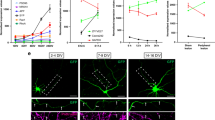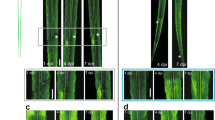Summary
Two hours after the goldfish optic tract was cut, the severed axons in the retinal stump of the tract showed ballooning of the axoplasm and myelin sheath in the region of the cut, with accumulation in the swollen axon of various organelles, including dense cored vesicles. By day 1 the myelin sheath had degenerated back to a node of Ranvier and the tip of the severed axon had formed a myelin-free terminal bulb with a well-organized core of 9–10 nm filaments. By 2 days, such terminal bulbs were often seen to be extended on a neck of cytoplasm a few micrometers in length, presumably indicating axonal outgrowth. In addition, occasional small bundles of axon sprouts were first seen at this time. The sprouts had a diameter of about 2 μm and contained a central core of 9–10 nm filaments surrounded by a mantle of cell organelles (smooth endoplasmic reticulum, mitochondria and diverse vesicles), with few if any microtubules. Sprouts within a bundle were separated by fairly uniform 10–15 nm spaces. Beginning at 3 days, significant numbers of microtubules appeared in the sprouts, and there was an increasing proportion of small diameter (⩾0.3 μm) sprouts. Thus it was not until 3 days that the sprouts took on the appearance usually considered to be typical of regenerating axons. By 6 days a dense layer of glial cells or macrophages formed a cap over the cut surface of the tract. Penetrating this layer were bundles containing up to 20–30 axon sprouts and also single axons which may have been serving as ‘pioneering’ fibres to which later-emerging axons would attach. There was no evidence that the regenerating axons were guided by the glial cells. At 6 days astroglia began to separate individual axons within the bundles but oligodendrocytes were still inactive at this time.
Similar content being viewed by others
References
Attardi, D. G. &Sperry, R. W. (1963) Preferential selection of central pathways by regenerating optic fibers.Experimental Neurology 7, 46–64.
Bunge, M. B. (1977) Initial endocytosis of peroxidase or ferritin by growth cones of cultured nerve cells.Journal of Neurocytology 6, 407–39.
Easter, S. S., Jr, Kish, P. E. &Scherer, S. S. (1979) Growth and development of the optic nerve in juvenile goldfish.Society for Neuroscience Abstracts 5, 158.
Gaze, R. M. (1970)The Formation of Nerve Connections, pp. 130–132. London: Academic Press.
Grafstein, B. (1971) Role of slow axonal transport in nerve regeneration.Acta Neuropathologica Suppl.V, 144–52.
Grafstein, B. &McQuarrie, I. G. (1978) Role of the nerve cell body in axonal regeneration. InNeuronal Plasticity (edited byCotman, C. W.), pp. 155–195. New York: Raven Press.
Grafstein, B. &Murray, M. (1969) Transport of protein in goldfish optic nerve during regeneration.Experimental Neurology 25, 494–508.
Hajós, F., Csillag, A. &Kálmán, A. (1979) The morphology of microtubules in incubated synaptosomes. Effect of low temperature and vinblastine.Experimental Brain Research 35, 387–93.
Horder, T. J. (1974) Electron microscopic evidence in goldfish that different optic nerve fibres regenerate selectively through specific routes into the tectum.Journal of Physiology 241, 84–5P.
Kao, C. C., Chang, L. W. &Bloodworth, J. M. B., Jr (1977) Electron microscopic observations of the mechanisms of terminal club formation in transected spinal cord axons.Journal of Neuropathology and Experimental Neurology 36, 140–56.
Lentz, T. L. (1967) Fine structure of nerves in regenerating limb of the newt Triturus.American Journal of Anatomy 121, 647–70.
Maloney, G. J. (1975)The morphology of the normal and regenerating optic nerve in goldfish, a light and electron microscopic study. Ph.D. Thesis, Indiana University, Bloomington, Indiana.
Maloney, G. J. (1976) Neuroma formation during optic nerve regeneration in goldfish.Anatomical Record 184, 468 (abstract).
Morris, J. H., Hudson, R. A. &Weddell, G. (1972) A study of degeneration and regeneration in the divided rat sciatic nerve based on electron microscopy. III. Changes in the axons of the proximal stump.Zeitschrift für Zellforschung und mikroskopische Anatomie 124, 131–64.
Murray, M. (1973)3H-uridine incorporation by regenerating retinal ganglion cells of goldfish.Experimental Neurology 39, 489–97.
Murray, M. (1976) Regeneration of retinal axons into the goldfish optic tectum.Journal of Comparative Neurology 168, 175–96.
Murray, M. &Grafstein, B. (1969) Changes in the morphology and amino acid incorporation of regenerating goldfish optic neurons.Experimental Neurology 23, 544–60.
Nordlander, R. H. &Singer, M. (1978) The role of ependyma in regeneration of the spinal cord in the urodele amphibian tail.Journal of Comparative Neurology 180, 349–74.
Pellegrino De Iraldi, A. &De Robertis, E. (1968) The neurotubular system of the axon and the origin of granulated and non-granulated vesicles in regenerating nerves.Zeitschrift für Zellforschung und mikroskopische Anatomie 87, 330–44.
Peters, A. &Vaughn, J. E. (1967) Microtubules and filaments in the axons and astrocytes of early postnatal rat optic nerves.Journal of Cell Biology 32, 113–9.
Reier, P. J. &Webster, H. deF. (1974) Regeneration and remyelination ofXenopus tadpole optic nerve fibres following transection or crush.Journal of Neurocytology 3, 591–618.
Stensaas, L. J. &Feringa, E. R. (1977) Axon regeneration across the site of injury in the optic nerve of the newtTriturus pyrrhogaster.Cell and Tissue Research 179, 501–16.
Turner, J. E. &Singer, M. (1974) The ultrastructure of regeneration in the severed newt optic nerve.Journal of Experimental Zoology 190, 249–68.
Watson, W. E. (1969) The response of motor neurones to intramuscular injection of botulinum toxin.Journal of Physiology 202, 611–30.
Weiss, P. (1955) Nervous system (Neurogenesis). InAnalysis of Development (edited byWillier, B. H., Weiss, P. andHamburger, V.), pp. 346–401. Philadelphia: Saunders.
Wolburg, H. (1978) Growth and myelination of goldfish optic nerve fibers after retina regeneration and nerve crush.Zeitschrift für Naturforschung 33c, 988–96.
Zeleńa, J., Lubińska, L. &Gutmann, E. (1968) Accumulation of organelles at the ends of interrupted axons.Zeitschrift für Zellforschung und mikroskopische Anatomie 91, 200–19.
Author information
Authors and Affiliations
Rights and permissions
About this article
Cite this article
Lanners, H.N., Grafstein, B. Early stages of axonal regeneration in the goldfish optic tract: An electron microscopic study. J Neurocytol 9, 733–751 (1980). https://doi.org/10.1007/BF01205016
Received:
Revised:
Accepted:
Issue Date:
DOI: https://doi.org/10.1007/BF01205016




